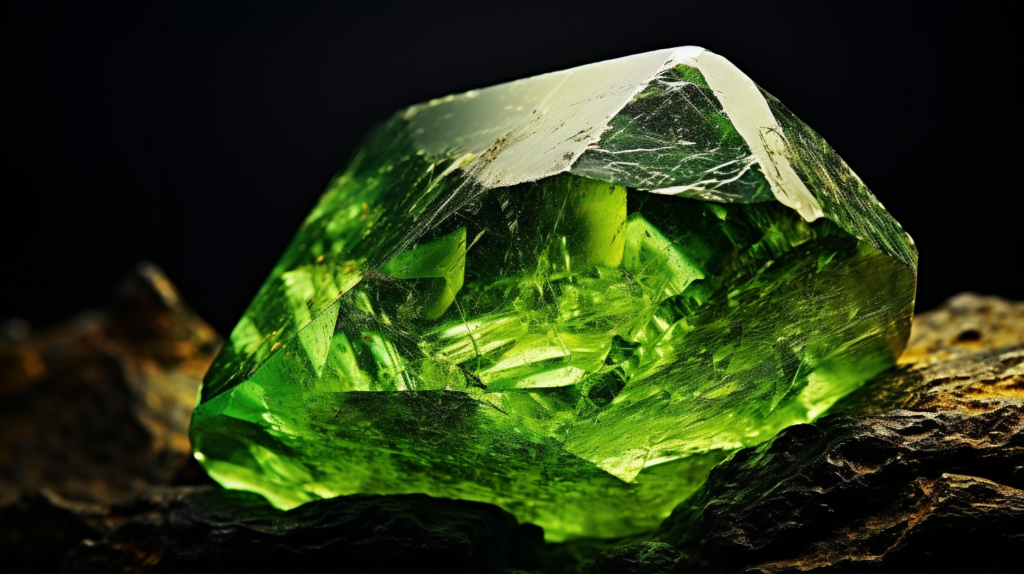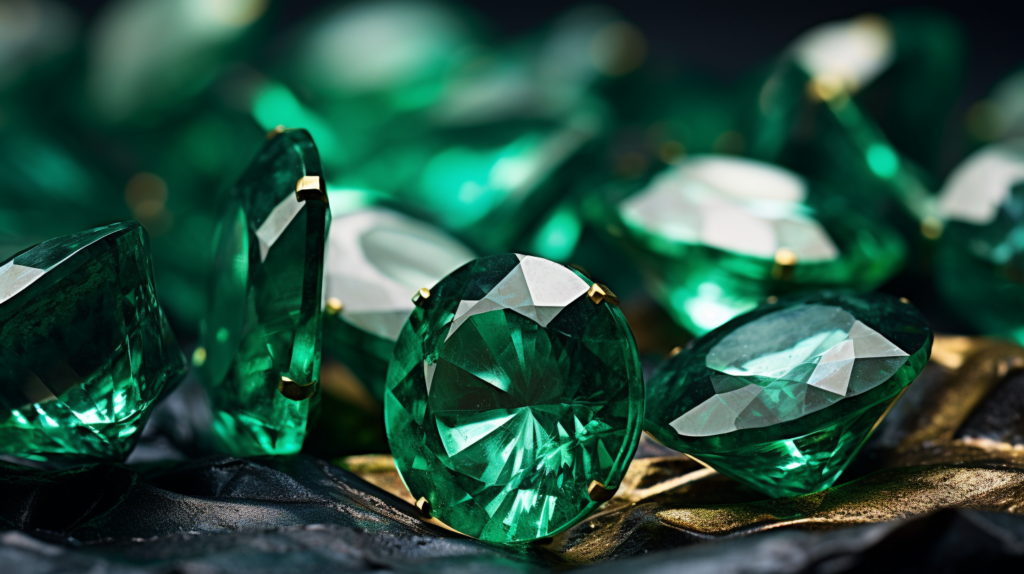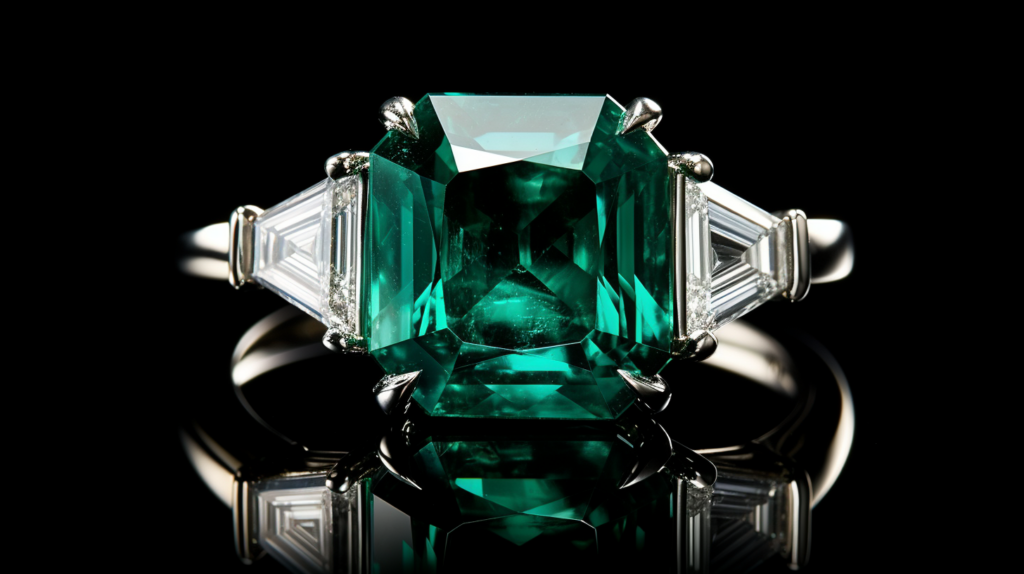Welcome to the extraordinary realm of green diamonds with BrighterGuide as your companion. Have you ever dreamed of possessing a gem that not only stands out remarkably but also boasts stunning beauty? Join us on an unforgettable exploration into the captivating universe of green diamonds, where you’re about to be totally blown away by these stunning, out-of-the-ordinary gems.
With a rare beauty that’s hard to find, green diamonds capture the astonishing wonders nature has gifted us with. Their unmatched natural beauty stands as a vibrant testament to the breathtaking artistry of nature. We’re about to plunge into the enthralling narrative of green diamonds, uncovering their birth deep in Earth’s core and how they’re meticulously sculpted to shine as a bewitching rarity.
Green diamonds spark intrigue with their rare, vivid green hue formed underground over billions of years. Let’s eagerly delve into the dazzling world of green diamonds to illuminate their captivating wonders. Discover the magic with us!
Related article: A Guide to Gemstone Diamonds
Key Takeaways
- Green diamonds owe their unique hue to prolonged exposure to atomic radiation and impurities like nitrogen, hydrogen, or nickel, with genuine ones identifiable by a ‘natural’ inscription like a radiation stain.
- The intensity of a green diamond’s hue, ranging from faint green to fancy deep, significantly impacts its value, with pristine ones without secondary shades being especially coveted. Blue Nile recognizes the allure of these exquisite gems, offering a curated green diamond selection that captures the essence of nature’s rare beauty.
- While green diamonds are not the rarest stones, they still rank high in this aspect, and their scarcity and unique coloration directly influence their price per carat in the market.

Origin of Green Diamond’s Color
Unraveling the mystery behind the green diamond’s color is nothing short of intriguing. When we talk about natural green rough diamonds or any colored stones like blue diamonds, their unique shades stem from impurities or structural defects residing in the diamond’s crystal lattice framework. For green diamonds, their signature tint is the result of natural exposure to atomic radiation, like gamma rays over eons. Such exposures lead to the formation of color hub crystal structure, which involve elements like nitrogen, hydrogen, or nickel impurities, endowing the diamond with its green shade. And, rest assured, possessing a green diamond doesn’t pose any risk as radiation traces are negligible.
Professional gemologists can pinpoint natural color in diamond by spotting a ‘Natural’ inscription on its edge, which attests to its genuine color that hasn’t been modified artificially. The esteemed Gemological Institute of America (GIA) categorizes green diamonds ranging from faint green to the more vibrant categories like fancy intense, fancy vivid, and fancy deep. Those green diamonds that don’t possess secondary colors are especially in demand and fetch high sums. Secondary hues in green diamonds might encompass colors like yellow, yellowish green, blue, brown, and gray, or a mix of these.
To really nail the value of a green diamond, it’s essential to understand where its color originates from. This know-how helps those in the market for a diamond to tell apart real green diamonds from lab-created ones. Green diamonds have varying levels of intensity that impact overall value.
Green Diamond’s Intensity Levels
Grasping the intensity nuances of green diamonds is vital for ascertaining their exclusivity and worth. The vividness of a diamond’s green hue is influenced by multiple facets, including its natural origin and the degree of natural irradiation it endured over ages.

Here’s a breakdown of the color intensity benchmarks for green diamonds:
- Faint Green: This category comprises diamonds that exhibit a mere hint of green. Their greenish undertone might be understated and not very conspicuous.
- Very Light Green: Such diamonds possess a marginally pronounced green tint color saturation compared to faint green ones. Their green light is perceptible yet remains somewhat muted.
- Light Green: This bracket encompasses diamonds that manifest a medium green hue. Their green color stands out prominently.
- Fancy Intense, Fancy Vivid, and Fancy Deep: Representing the pinnacle in color intensity for green diamonds, stones in these classifications exude a rich, dark green to a fancy deep blue-green shade. The intensity escalates from intense to vivid and peaks at dark and deep.
It’s pivotal to emphasize that while pristine green diamonds devoid of secondary shades are highly esteemed, many green diamonds exhibit secondary shades, such as blue or yellow. The presence of such additional colors can influence the overarching color intensity grading of the diamond.
Are Green Diamonds Rare?
In the grand spectrum of diamond colors, while green diamonds aren’t as elusive as shades like red, pink, blue, violet, or orange, they still rank high on the rarity scale. This limited availability amplifies their mystique, rendering them highly coveted by aficionados and experts.
While green diamonds are relatively rare, they are not as hard to come by as some other colored variants. Still, their limited occurrence elevates their allure, making them a splendid choice for green diamond jewelry and engagement rings.

Their sky-high prices are largely due to how rare these green diamonds are. Especially natural-color green diamonds fetch premium prices owing to their limited numbers. Whether it’s a green diamond with a cushion-cut or a radiant ring graced by an exclusive green gem, their limited availability only enhances their distinct charm and prestige.
Green diamonds are rare and pricey because of their captivating green color.
Green Diamonds Rarity and Prices
To understand the rarity and associated price tags of green diamonds, it’s crucial to recognize that these rare gems command premium prices due to their limited numbers and distinctive hues. Key considerations include:
- Limited Availability: A green color diamond family is a rare find, with a mere fraction (less than 0.1%) of all diamonds showcasing this natural hue. This scarcity directly translates to their elevated prices in the diamond market.
- Unique Coloration: The green shade of these diamonds is a result of enduring natural radiation over extensive time periods. Many green diamonds exhibit a superficial green tint, dubbed as ‘skin’. Authentic green diamonds, devoid of any secondary hues like blue or yellowish brown stains, are treasured.
- Carat Natural Weight: Green diamonds weighing below 1 carat are deemed rare and thus valuable. The weight of a green carat diamond plays a pivotal role in its valuation.
- Overall Quality: Multiple factors like color depth, size, and intrinsic quality dictate the price point of green diamonds. The deeper, purer, and more uniform color the green shade, the more valuable the diamond.
Considering their scarcity and unique shades, green diamonds occupy a revered position in the diamond world. Now, let’s delve into what makes these jewels so precious.
Are Green Diamonds Valuable?
Indeed, green diamonds are treasures due to their limited occurrence and unparalleled hue. These gems, known as colored diamonds or more precisely, fancy-color diamonds, are cherished for their unique hues. How much a green diamond is worth really comes down to a few key things: its weight, the intensity of its color, and just how good quality it naturally is.
Tips for Buying Green Diamonds
When contemplating the purchase of a green diamond, emphasizing the color’s origin is vital. Here are some pointers:
- Lab-grown green diamonds: If you seek an environmentally conscious and cost-efficient choice, lab-grown diamonds are worth considering. These synthetic diamonds mirror the chemical composition and crystalline structure of their natural counterparts.
- Demand a natural diamond grading report: To ensure your green diamond’s authenticity, always request a natural diamond grading report from a trusted gemological institute. This document attests to the color’s origin and offers invaluable insights about the gem.
- Distinguish between synthetics and simulants: It’s crucial to differentiate between lab-grown green diamonds and diamond simulants – mere replicas of real diamonds. To confirm the authenticity of a green diamond, ensure it possesses optical properties synonymous with natural diamonds.
- Establish a budget: The price spectrum for green diamonds is broad, influenced by facets like size, color depth, and intrinsic quality. Define a budget aligned with your preferences, and weigh the trade-offs among these factors to identify your ideal green diamond.
With these guidelines, you’re well-equipped to traverse the realm of green diamonds and make a well-informed acquisition.
Next, let’s discuss green diamond engagement ring styles.
Green Diamond Engagement Ring Settings
Discussing green diamond engagement ring designs, three predominant styles emerge.
The foremost is the timeless solitaire design, which accentuates the green diamond, making it the ring’s centerpiece.
The next is the halo style, wherein the green diamond is encased by tinier transparent diamonds, resulting in a captivating spectacle.
Lastly, the three-stone design augments the diamond surface area, potentially featuring flanking stones in emerald or tapering baguette configurations.
Each design has its distinctive allure, potentially augmenting the splendor of a green diamond engagement ring.

Style 1: Solitaire Setting of Green Diamonds
For those gravitating towards a timeless appeal, the solitaire setting is the go-to for green diamond engagement rings. This design underscores the grace and sophistication of the green diamond, making it the ring’s standout feature. Here’s why the solitaire setting resonates with green diamond engagement rings:
- Accentuating the Hue: The solitaire setting draws all attention to the green diamond, accentuating its distinctive hue. Regardless of whether it’s a muted or vibrant shade, the solitaire setting magnifies its splendor.
- Enduring Sophistication: The minimalist approach of the solitaire setting radiates timeless sophistication. It offers a refined aesthetic that’s cherished across generations.
- Adaptability: The solitaire design is versatile, compatible with diverse shapes and sizes of green diamonds. Be it a pear-shaped or a 1-carat oval diamond, the solitaire setting can be customized to accommodate any gem.
- Classic Allure: The solitaire setting, with its longstanding association with engagement rings, symbolizes undying love and dedication. Opting for this design for a green diamond engagement ring infuses a classic vibe with a distinctive twist, crafting a jewelry masterpiece that’s both timeless and exceptional.
Style 2: Halo Setting
The halo setting gloriously complements the green diamond, imparting a radiant shimmer to the ring. This design features a central shield-shaped diamond surrounded by smaller transparent diamonds, crafting a halo effect. The stark contrast between the vibrant green core and the lustrous surrounding diamonds offers a visual feast.
The halo setting not only amplifies the green diamond’s allure but also adds depth and intricacy to the overall design. When opting for a halo setting for a green diamond engagement ring, it’s pivotal to weigh the central stone’s color depth and shade, as well as the peripheral diamonds’ quality.
High-resolution imagery and color in gem diamonds’ grading report can guide the selection of the ideal halo setting.
Transitioning to ‘style 3: three stone setting’, let’s delve into how this design uniquely showcases the green diamond.
Style 3: Three Stone Setting
Progressing in our exploration of green diamond engagement ring designs, the spotlight now shifts to the three stone setting style.
This design spotlights three diamonds, with the central green diamond flanked by two complementary stones on either side.
Key attributes of the three stone setting for green diamonds include:
- Enhanced Surface Area: Incorporating three stones in this setting amplifies the brilliance and sparkle when the ring catches light.
- Flanking Stones: The adjacent stones in a three stone design can be tailored in diverse shapes, such as emerald or tapering baguette, refining the ring’s overall aesthetics.
- Symbolic Connotation: The trio in this setting can metaphorically represent a relationship’s past, present, and future, infusing the engagement ring with sentimental value.
- Customization Potential: The three stone design offers ample scope for customization in terms of diamond shape and dimension, crafting a personalized piece aligning with individual tastes.
Given their distinctive design and profound symbolism, three stone settings resonate with many eyeing green diamond engagement rings. Next, we’ll touch upon other prevalent jewelry designs tailored for green diamonds.
Popular Jewelry Settings for Green Diamonds
For those seeking to embed green diamonds in jewelry, there’s a plethora of sought-after designs to pick from. The chosen setting can magnify the diamond’s brilliance, ensuring it’s showcased in its full glory.
These designs are available at reputed diamond jewelry stores, offering myriad options aligning with individual preferences. When zeroing in on a setting for a green diamond, aspects like the diamond’s quality, its natural color roots, and meticulous polishing should be top of mind. Additionally, verifying the diamond certificate by esteemed diamond grading laboratories is essential, attesting to its genuineness and value. Whether the choice is a solitaire, halo, three-stone, or side stone setting, each option is adept at highlighting green diamonds’ mesmerizing traits.

When exploring diamonds, the origin of color is a key component. The color in diamonds is largely attributed to the arrangement of carbon atoms within their structure. Colorless diamonds, though the most familiar, don’t capture the allure of their colored counterparts.
Their clarity scale and color grade, as determined by gemological laboratories, plays a pivotal role in their valuation. Green diamond intensity levels, owe their hues to natural inclusions, complex defects, or exposure to radioactivity over hundreds of thousands of years.
For instance, the 5.03-carat aurora green diamond or the 41-carat, pear-cut diamond both showcase the marvel of nature’s palette. Understanding the clarity, such as vs2 clarity, can also be crucial.
Diamond experts, like those at Leibish & Co., often share articles about color of diamonds, giving insights into diamond grading and the diamond buying process. Remember, when looking for polished diamonds, always ensure the authenticity through a diamond identification report to ensure a valuable purchase.
You Might Like
For those captivated by green-colored diamonds and keen on expanding their collection, exploring other rare colored diamonds might be enticing. Here’s a glimpse of what’s on offer:
- Light Green Diamonds: For those enchanted by the subtle charm of light green diamonds, venturing into other muted shades like yellow diamond or lime green diamonds might be intriguing. These gems exude a cozy, inviting aura, seamlessly blending elegance into any jewelry item.
- Diamond Grading: For the discerning eye keen on immersing in the colored diamond universe, the science of diamond grading could be riveting. Gaining insights into factors like color depth, clarity, and cut can foster a profound understanding and appreciation of these radiant gems.
- Carat Green Diamonds: While sub-1 carat green diamonds are already a rarity, the allure of heftier green diamonds might be irresistible. Diving into the domain of larger green diamonds unravels an array of opportunities to craft statement pieces exuding unparalleled grandeur.
- Artificially-Colored Diamonds: Those keen on exploring alternative diamond coloring techniques might be intrigued by artificially-colored diamonds. Such diamonds undergo specific treatments or enhancements to manifest their vibrant hues. For instance, a bluish olive green synthetic diamond offers an alluring, distinct alternative to natural green diamonds.
Conclusion
From unraveling the mysteries of green diamond origin to exploring intensity levels and rarity factors, this guide equips you with insights into the realm of green diamonds. Whether you’re drawn to classic solitaire settings, mesmerizing halo designs, or symbolic three-stone arrangements, discover the perfect style for your green diamond engagement ring. Explore the wide range of colored diamonds and delve into the world of rare gems with Blue Nile, your trusted source for exquisite diamond jewelry.
Sources
BrighterGuide is dedicated to providing accurate and relevant information as you explore the wonderful world of diamonds and jewelry. To this end, our writers refer to primary information sources in building each article that appears on this website. These include, but are not limited to, published news articles, government portals, research papers, and more.
- Natural Colored Diamond Reports & Services. (n.d.). https://www.gia.edu/gem-lab-service/colored-diamond/
- International Gem Society LLC. (2022, October 19). International Gem Society IGS – Information and educational services for everyone interested in gemstones. https://www.gemsociety.org/